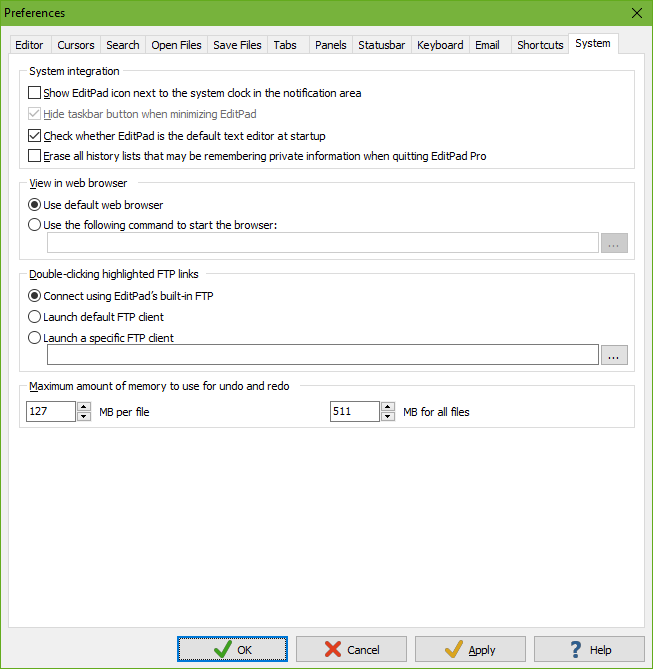
On the System page in Options|Preferences, you can make some choices how EditPad Pro interacts with the rest of your computer and network.

If “Show EditPad icon next to the system clock in the notification area” is activated, a green EditPad icon will be visible next to the system clock (this area is called the “notification area”) when EditPad is running. When you close EditPad in this situation, it will not really close but only hide itself so the system tray icon remains visible. You can then make EditPad quickly reappear by clicking on the system tray icon. You can right-click on it to quickly start with a new file or open an existing one. To completely shut down EditPad, select File|Exit in the menu.
Turn off this option to make EditPad behave like a regular Windows program.
When the “Show EditPad icon next to the system clock in the notification area” option is activated, you can choose if you want EditPad’s button on the taskbar to hide or not when you minimize EditPad by marking or clearing “Hide taskbar button when minimizing EditPad”. Note that the taskbar button will always hide when you close EditPad.
Turn on “check if EditPad is the default text editor at startup” if you want EditPad to check whether it is still associated with .txt files each time you start it. If this option is on, and EditPad detects it is no longer associated with .txt files, it will ask you whether you want EditPad to associate itself with .txt files or not.
Turn on “erase all history lists that may be remembering private information when quitting EditPad Pro” to make EditPad Pro forget the lists of recent items kept by these commands:
If the View|Browser doesn’t properly detect your web browser, you can specify a specific application to be used as the web browser. Click the (...) button to browse for the .exe file of the application you want to use. You can also manually enter a command line. If you include %URL% as part of the command line parameters, that placeholder will be substituted with an http:// or file:// URL to the file to be opened. If you don’t enter %URL% on the command line, EditPad Pro will launch the .exe with the URL as the sole command line parameter.
EditPad Lite will always open FTP links in your computer’s default FTP client. EditPad Pro provides three choices. The default is to use EditPad’s built-in FTP. This is the most comfortable option to edit files stored on FTP servers. The “launch default FTP client” runs whichever application is configured on your computer to handle ftp: URLs.
Finally, you can specify a specific application to be used as the FTP client. Click the (...) button to browse for the .exe file of the application you want to use. You can also manually enter a command line. If you include %URL% as part of the command line parameters, that placeholder will be substituted with an ftp:// URL to the file to be opened. If you don’t enter %URL% on the command line, EditPad Pro will launch the .exe with the URL as the sole command line parameter.
As explained in the help topic for the Edit|Undo command, EditPad normally keeps an undo history for all changes you’ve made to all files that you have open in EditPad since you opened them. During very heavy editing sessions, this may cause the undo history to use too much memory. As a safeguard, EditPad will automatically discard the oldest changes from the undo history when it grows too large. In EditPad Lite these limits are automatically set based on the amount of RAM your PC has. In EditPad Pro, you can configure the limits yourself.
The limit per file limits the undo history for each individual file. If the undo history for a file grows beyond this point, the oldest changes for that file are discarded from its undo history. EditPad does this even if there are older changes in other files, and even when the total undo history size for all files has not yet exceeded the limit for all files.
The limit for all files limits the combined size of the undo history for all open files. If the total undo history size grows beyond this point, the oldest changes are discarded from the undo history. EditPad does this regardless of which file(s) the oldest changes were made in, and regardless of how much memory the undo history for those files uses.
Set the limit for all files to allow enough free memory for the files themselves that you edit in EditPad, as well as for Windows and for all the other applications you’re running. Set the limit per file lower than the limit for all files to make sure that making lots of changes to one file does not clear out the undo histories for all the other files you have open in EditPad.